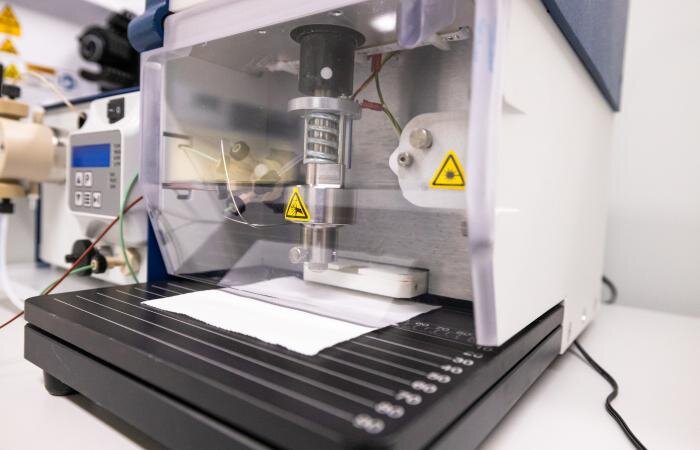Analytical chemists at the Department of Energy’s Oak Ridge National Laboratory have developed a rapid way to measure isotopic ratios of uranium and plutonium collected on environmental swipes, which could help International Atomic Energy Agency analysts detect the presence of undeclared nuclear activities or material.
“This method builds on a commercial microextraction probe to directly sample solids and subsequently extract the analytes from a surface and into a flowing solution,” said ORNL’s Benjamin Manard. He led the proof-of-concept study, which demonstrated that this sampling mechanism was effective at extracting actinide material (e.g., uranium and plutonium) from environmental swipes. The paper made the front cover of the journal Analytical Chemistry.
This innovation could help IAEA’s Network of Analytical Laboratories, or NWAL, which includes ORNL, analyze samples collected from facilities worldwide. DOE NWAL coordinator and co-author Brian Ticknor said, “The microextraction method, if it achieves suitable precision and accuracy, could enable higher sample throughput and faster turnaround time.”
The pen-sized microextraction probe in Advion’s Plate Express product uses a “wet vacuum” to mobilize material from a swipe surface. Manard’s team couples the probe to an instrument that subjects the extracted material to a plasma—an ionized gas hotter than the surface of the sun—and measures the mass-to-charge ratios of the ions generated from the sample.
“It truly is an integrated system,” Manard said. An analyst places a swipe on the extraction stage, selects a region of interest and initiates the process by pressing a button. The microextraction probe lowers onto the swipe, seals it to the stage surface and delivers an acid solvent that dissolves any actinides present in the swipe. Then the solution containing the actinide moves into a mass spectrometer for analysis. “With just a click of a button, you’re going from a solid sample on a swipe to an isotopic measurement,” he said.
With this novel approach to assaying solids, co-author Kayron Rogers of ORNL made a series of swipe samples containing varying amounts of reference standards. The team was able to detect as little as 50 picograms of uranium—80 million times lighter than a grain of sand. Moreover, the researchers made precise and accurate measurements of the ratios of major and minor isotopes of elements in nuclear reference materials. In a subsequent study, they applied the technique to the analysis of plutonium.
“The benefits of this methodology could extend beyond nuclear material analysis, to many applications requiring direct elemental analysis,” Manard said.
Traditionally, analysts ash inspection samples in a furnace before acid digestion and lengthy chemical separations. The process from ashing to analysis could typically take up to 30 days. “The goal of this project was to cut down on those steps in the beginning—ashing and dissolution,” Manard said. “If we could sample the swipe directly, we don’t have to go through the process of trying to turn a swipe into a liquid.”
The researchers work in ORNL’s Ultra-Trace Forensic Science Center, a service center and research facility providing expertise and state-of-the-art inorganic mass spectrometry instrumentation. “This project brings together ideas and technologies developed at ORNL that could provide the next revolutionary change to environmental sampling methodology,” said co-author Cole Hexel, who leads the lab’s Chemical and Isotopic Mass Spectrometry Group.
The researchers are excited about experiments to be conducted over the next two years that will examine the versatility of the methodology.
An innovative approach led by co-author Shalina Metzger is to put a chromatography column between the microextraction probe and the mass spectrometer and have actinide-containing solutions flow through connective tubing. Whereas the column would allow uranium to flow through, it would retain plutonium for later elution and measurement. The approach would improve elemental sensitivity and identification.
During their studies, the researchers found that nitric acid degraded the microextraction probe head. Future experiments will seek to optimize solvent conditions for extracting actinides in various chemical forms. “We’re also using ORNL’s unique 3D-printing facilities to fabricate components with polymers that are more resistant to the extraction solvent,” Manard said.
Ultimately, the ORNL researchers hope to develop the capability to differentiate individual analytes collected on a swipe to provide a holistic snapshot of an inspected facility’s activities. Their coupled microextraction and mass spectrometry methodology shows promise as a revolutionary approach toward that aspiration. Manard’s team is hopeful that the coming years of research will prove fruitful and turn this goal into a reality.
Novel NRL instrument enhances ability to measure nuclear materials
More information:
Benjamin T. Manard et al, Direct Uranium Isotopic Analysis of Swipe Surfaces by Microextraction-ICP-MS, Analytical Chemistry (2021). DOI: 10.1021/acs.analchem.1c01569
Provided by
Oak Ridge National Laboratory
Citation:
Quick detection of uranium isotopes helps safeguard nuclear materials (2021, October 15)
retrieved 16 October 2021
from https://phys.org/news/2021-10-quick-uranium-isotopes-safeguard-nuclear.html
This document is subject to copyright. Apart from any fair dealing for the purpose of private study or research, no
part may be reproduced without the written permission. The content is provided for information purposes only.



